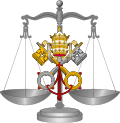History
In the Middle Ages, the temporalities were usually those lands that were held by a bishop and used to support him. The distinction between "temporals" and "spirituals" emerged during the Investiture Crisis, as a way to resolve conflicts over ecclesiastical authority. This separation of secular and spiritual responsibilities within church offices was formalized in the Concordat of Worms. According to its conditions, the temporalities of a diocese were granted to the bishop by the secular ruler after the bishop was consecrated. [2]
If a bishop within the Holy Roman Empire had gained secular overlordship to his temporalities imperially recognised as an imperial state, then the temporalities were usually called a Hochstift , or an Erzstift (for an archbishop). Sometimes, this granting of the temporalities could take some time. Other times, a bishop-elect gained his temporalities even before or without his papal confirmation by an imperial act called "liege indult" (Lehnsindult). The temporalities were often confiscated by secular rulers to punish bishops.
Temporalities that involved sovereign or governmental authority were effectively abolished during Germany's secularization. What remained was largely converted into state-funded benefits, with their scope defined by concordats and circumscription bulls.
In the context of the Catholic Church's disputes with the Spanish government during the nineteenth century, Pope Gregory XIV reiterated the Church's "innate right to acquire and possess temporal goods" (nativo diritto la facoltà di acquistare e possedere beni temporali) in an address to the consistory in 1841. [3]
This page is based on this
Wikipedia article Text is available under the
CC BY-SA 4.0 license; additional terms may apply.
Images, videos and audio are available under their respective licenses.
